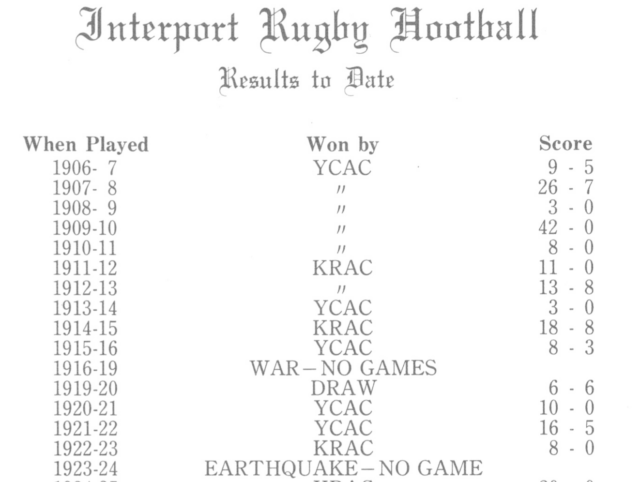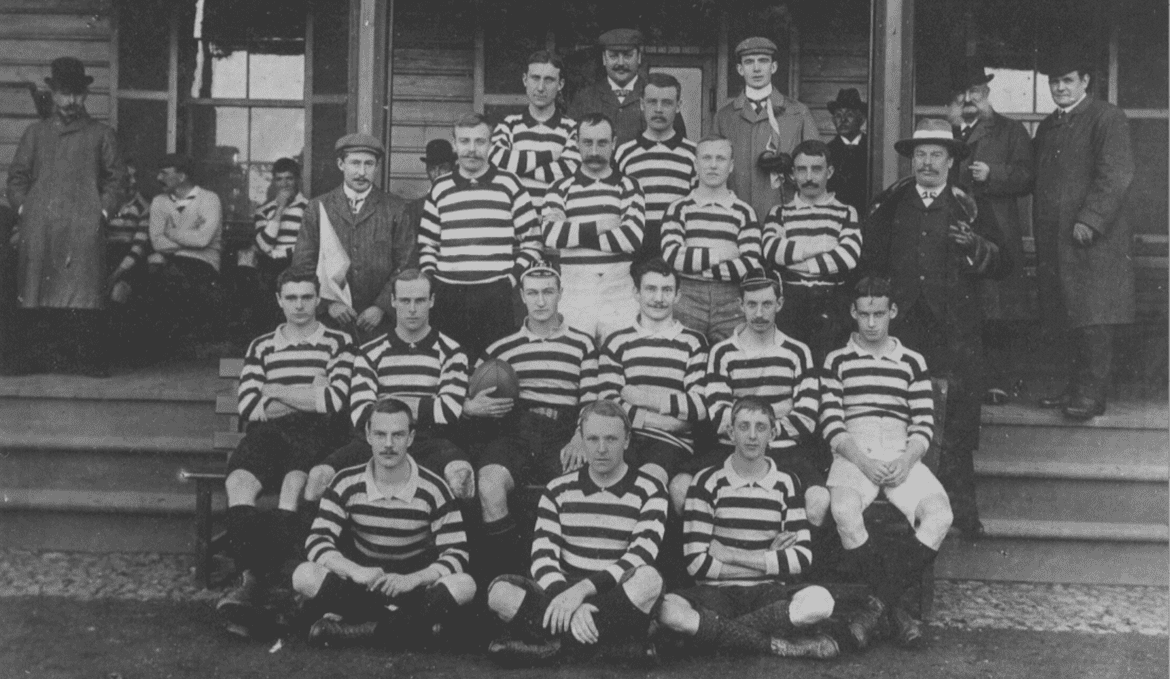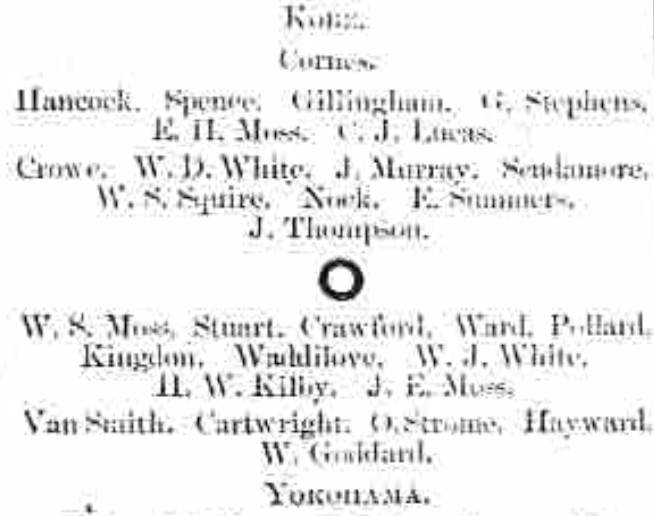Background
At the end of the 19th century the two leading international trading ports in Japan were Yokohama and Kobe and they were both home to foreign sports clubs, the largest of which were the Yokohama Cricket and Athletic Club (YC&AC) and the Kobe Regatta and Athletic Club. (KR&AC). Not long after the latter was founded in 1870, the club’s founder, Alistair Sim, a keen rower, challenged the rowing club in Yokohama to races and in September 1871 brought his boats and his four oarmen and cox to Yokohama by ship as there was no train and the first interport sporting events took place. In 1886 interport cricket matches began followed by soccer and baseball interports which started in 1888 and 1896 respectively. Unfortunately only the photo of the 1902 Kobe team has survived.

Rugby needs fifteen players and reserves and so it was not until 1902 that the first rugby interport took place but it quickly became the toughest and the most watched interport. Because the first Japanese rugby team only played its first match (against the YC&AC) in 1901 and the second Japanese team was not established until around 1910, the interport rugby fixture was/is the oldest fixture and longest running rugby fixture in Japan and, naturally, it was the main fixture of the year for both clubs and followed by a black tie dinner. Moreover, in 1902 the merchants in Kobe decided to collect money and create the “Interport Shield” which today hangs on a wall in the YC&AC because the YC&AC was the winner in the last inteport match played. This is Japan’s oldest and biggest rugby trophy. Unfortunately, the fixture hasn’t been played since around 2006 because KR&AC have been unable to field a team. Hopefully, this problem will be resolved soon and the fixture restarted.
War and 1923 earthquake resulted in the early rugby interport history getting lost
At the annual rugby interport dinner a special menu was always prepared and it listed the interport results. If you look at the list of the results in the 1984 menu below, you can see that the first listed interport rugby match was in 1906! One feature of those interport matches in every sport was that they were recorded in great detail by at least one newspaper reporter. You will find the report of the 1902 match probably longer than any other rugby match you have read about. Enjoy.

Very back: W. D. White, J. Bathhurst (ref), H. F. Scudamore, S. Wheeler (linesman) Back: E. C. Jeffrey (linesman), J. G. Murray, A. J. Cornes, J. W. Thompson, E. H. Summers, F. J. Bardens (President)
Middle: A. H. Gillingham, H. C. R. Hancock (Capt.), E. F. Crowe, P. L. Spence, G. Stephens
Front: E. H. Moss, H. M. Nock, C. J. Lucas
1902 Match report in great detail published by the Kobe Weekly Chronicle
The first Interport Rughy football match between Yokohama and Kobe, played at Yokohama on Christmas Day, ended in a win for the northern team by a try to nil. The Japan Advertiser, whose account we condense, describes the game as one of ihe most, fiercely contested games ever witnessed on the Yokohama ground. The Yokohama forwards are considered an excellent pack, and it is to one of these —Waddilove —that Yokohama owed their try. The Advertiser says it is fair to say that Kobe’s back line combination was on the whole superior to their opponents, and early in the match matters more than once looked decidedly dangerous for Yokohama, when Hancock, both a fleet runner and a nasty tack, got possession and made one of his spectacular sprints. Stephens also made run in the second half, which, but for prompt checking, might have found a weak spot in the local panoply. With every credit given to the visitors for clever and determined play, it would be unjust to Yokohama not to any that the advantage rested with them even apart from the single try scored. They usually beat Kobe in the scrums, and for long intervals kept the oval in the visitors’ 25 or on the line. Lucas and E. H. Moss created a very favourable impression at half-back, and among the forwards, Murray, White and Crowe were indefatigable, though where all laboured strenuously it seems invidious particularise. At 3 p.m. there was a fair gathering of spectators and the game started with praiseworthy punctuality, with Kobe having won the toss and electing to play from the settlement end. A nasty cold wind blew right across the field of play throughout the afternoon, giving very little advantage to either side and rendering accurate kicking almost impossible. the visitors trooped on to the ground wearing red and yellow striped jerseys, the Yokohama colours being blue and white. The teams lined up as under:-

Kobe kicking off, followed up with a rush and assailed the home 25 on the left wing. Hancock gained temporary possession, but was speedily stopped, and the oval went into touch. Yokohama then began to screw the scrums and gradually forced the visitors back into mid-field, where Cornes cleared. J. Moss dribbled well and Hayward gained something. Then the forwards continued the good work, and, getting the ball at their toes, suddenly charged into Kobe’s 25, where Cornes was found wanting for the moment. Spence securing, passed to Hancock, who sprinted beautifully across mid-field and gained home territory before he could be stopped. Kobe was awarded a penalty kick for off-slde play, and as the ball lay in a good position not far from Yokohama’s goal-posts, considerable anxiety was felt when Lucas tried to clear the bar. Luckily for the homesters he failed, but as the Kobe forwards were speedily on the ball a disaster was only averted by Waddilove touching down. Yokohama took advantage of the drop out to make tracks for the land of promise, and the visitors’ 25 was again invaded on the right wing. Cartwright secured and negotiated a fair run, but was hold, and out of the next scrum Hancock froze on to the oval, and, eluding his pursuers, carried it back to the local 25 line, where he relinquished possession with a swift kick. White of Kobe tried conclusions with J. Moss, and came off second best, but soon rejoined the fray. J. Moss was at this juncture putting up a most determined and plucky in the scrums and helping appreciably to repel the visitors’ attack. B. W. Kilby gained possession and ran nicely into the visitors’ 25, where Yokohama constantly beat their opponents, who were hard put to it to defend themselves. Suddenly the ball broke away, and the play spread out, Hancock eluding Hayward but failing to find a good opening. A series of rapid throws out of touch ensued, the homesters generally making the better of them. Once more the pack split up, and the ball flew away into the centre, where J. Moss usefully cleared with a well-timed kick which led to another invasion of the visitors’ 25. Here Kilby passed to Hayward and the latter to Stroma, who almost succeeded in scoring. Soon after Van R. Smith made a good run but was forced into touch, and a moment later Kobe touched down. Some rather ragged play followed, until the homesters in their turn were awarded a penalty kick, which was taken by W. S. Moss. The wind, however, carried the leather to the left of the posts, and the visitors followed up the next drop-out with great determination, the Yokohama backs being found momentarily napping. The Kobe three-quartern did some pretty passing in centre, and Hancock securing, proved a drop loo much for J. Moss, who sought to intercept his wild career. The Kobe captain (Hancock) repeated these tactics, but was too close to the touch-line to get through, and Goddard effectively relieved the pressure. There was a return to the Kobe 25, and the men tumbled over each other in their eagerness. The home three-quarters seemed be working together rather better. The halves occasionally stuck too long to the ball, but sometimes this was almost inevitable. Half-time was called after Cartwright had made a good run.
On resuming, Spence returned well from Yokohama’s kick-off, but the Yokohama forwards quickly resumed their battering-ram tactics. Kilby effected an excellent kick into the Kobe 25, but Crowe, securing, dribbled cleverly along the touch-line to centre. From a scrum here the ball suddenly ascended and then descended to earth in the home 25, but before the Kobe pack could improve the advantage Goddard cleared. The forwards then charged and rushed the leather into Kobe territory once more, on the left wing. Breaking from a scrum Waddilove annexed the oval, and amid cheers dashed through head first and over the line. W. S. Moaa had little chance to convert in such a wind. Kilby cleared from the drop-out and a free-kick was soon afterwards given the homesters. Spence made a fair catch, but did not pain much by it, and Hancock absentmindedly playing offside, Yokohama got another free kick in mid-field which sent the hall across the goal-line, where Kobe touched down. The visitors then became aggressive, and assailed the local 25 with grim desperation. The local forwards, however, continued to make every ounce of weight tell in the scrums, and the tide of battle surged back into centre, whence Van R. Smith sprinted into the visitors’ 25. Much of the ensuing piny was loose and ragged, until the Kobe backs got a chance and some really fine passing was witnessed. Excitement ran high as the waning light showed that the end could not be far off. Kobe heeled out of the scrum, and Gillingham secured and passed to Stephens. Crowe gained a few yards, and a good kick by Spence followed. The game again became loose and rough. Kilby passed to Van K. Smith, who carried the ball a fair distance K. H. Moss for the visitors made a neat kick out of a scrum, and the next breakaway with an accompanying Kobe rush was well neutralised by Goddard. Kobe was again compelled to touch down at a critical moment. A Kobe free-kick was cleared by Kilby, but the visitors charged down again, and crossed the homesters’ 25 line, making the most strenuous efforts to score. W. J, White made a useful run to centre, and Van R. Smith crossed the field with his customary fleetness soon afterwards. A pass from Hancock to Stephens enabled the latter to distinguish himself with a beautiful sprint, and Hancock made another good run on the other side of the field. A pass from H. W. Kilby to Van K. Smith afforded that player in his turn an opportunity for one of the most brilliant runs of the afternoon, and had he been able to start more to the right with less of a detour, he might have got through. Intense excitement reigned until the whistle went, the “rooting” for both teams being vociferous and persistent. Strome charged past several of his opponents and one moment, and Van R. Smith was as keen as ever, but nothing resulted. Just before the whistle blew Ward made a notable dribble into the Kobe 25, and Squire had just kicked into touch when play ended, leaving Yokohama the victors by three points to nil.
Mr. J. H. Bathgate was, as usual, a capable referee the linesmen being Messrs. Wheeler (Yokohama) and Jeffrey (Kobe.)
Just before the match began the rival fifteens were photographed separately. The Kobe visitors were entertained at a private dinner at the Club on the evening of the 26th inst.
This Interport match on Christmas Day, 1902, is a historic game that symbolizes the dawn of rugby in Japan. With a diverse, international lineup, the record clearly shows how Kobe secured victory after a fierce contest. thank you Mike !